Solar battery charger: device and operating principle of solar charging
More and more connoisseurs of active recreation prefer to spend their holidays and weekends closer to pristine nature.But it is difficult for a modern person to refuse the benefits of civilization - who among us does not take a mobile phone, laptop or camera on a trip?
But if you have a solar-powered charger in your luggage, the problem with powering your devices will be solved. All that remains is to figure out how to choose the right device. The article we present will provide effective assistance in clarifying all issues.
The content of the article:
What is solar charging?
These chargers are capable of converting solar energy into direct electrical current. They can work with various models of navigators, players, laptops, phones, cameras and other portable devices.
But the charging time directly depends on the power of the device itself and the type of discharged device, therefore, in order to choose a truly practical and universal device, it is worth understanding its characteristics.
Design features of the device
The device itself consists of a crystalline panel, a charge/discharge level controller and a solar-to-electric energy converter.
Some models are also equipped with a buffer battery consisting of several lithium cells, which allows the device not only to convert, but also to accumulate energy in order to release a charge even in the dark.
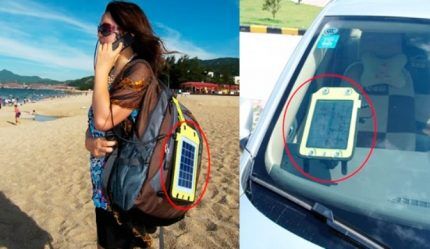
Advantages of solar chargers:
- Universal - adapted for various devices (USB connectors are provided on the case, and most models are additionally equipped with special adapters for various types of electrical equipment).
- Takes up little space in travel luggage.
- There is a wide selection of shapes, colors, sizes and power to suit different needs and aesthetic tastes.
Well, the most significant drawback for all solar chargers is the long time it takes them to accumulate “power”.In addition, it should be understood that if almost any model can handle powering a mobile phone or camera, then an active “absorber” of energy such as a laptop will already require impressive power from a solar battery and a capacitive battery.
How the device works
Portable solar-powered chargers are autonomous systems that can process energy both from rays and from the mains, fluorescent lamps or a computer. Moreover, many models do not need to have intense sun - they accumulate charge even on cloudy days, although the efficiency, of course, drops (from 20 to 70%).

The device works like this: crystals on the panel absorb solar energy, the converter “processes” it into electric current, which is supplied to the power source. When a mobile phone or other device is connected to this source using a cord, the accumulated energy gradually flows into the discharged device.
Types of solar chargers
As for the appearance, manufacturers have already tried not only to diversify the color scheme and shape of the devices, but also to make the device as convenient as possible for use in various situations. Let's look at the most popular options.
Monoblock – a compact device consisting of a panel and a drive enclosed in a solid metal or plastic case. Such a device will “save” a discharged phone on the beach or a picnic and will not take up much space in a regular bag.

Flexible panel – a thin folding or unfolding panel with photocells. It takes up little space in your luggage, and it weighs much less than its solid, enclosed competitor. But, despite the decent “coverage” area, flexible plates accumulate solar charge almost twice as slowly as monoblocks.
In addition, most panels operate only from direct sunlight, without storing energy for future use - they do not have a built-in battery. However, you can always supplement your charging with an external storage device of the required power.
So flexible panels are a good option for solving the problem of recharging low-power devices during a “stationary” vacation - in the country, fishing, with a tent. But for a hiking trip, it’s better to look at another option.

Built-in charging – the device consists of solar panels, which are attached to the outside of bags or travel backpacks. They allow you to recharge devices while traveling or store charge in the built-in battery.
This accessory can also be used for its intended purpose - to carry any objects or electronics, which is very convenient for those who are fond of hiking or working outdoors.
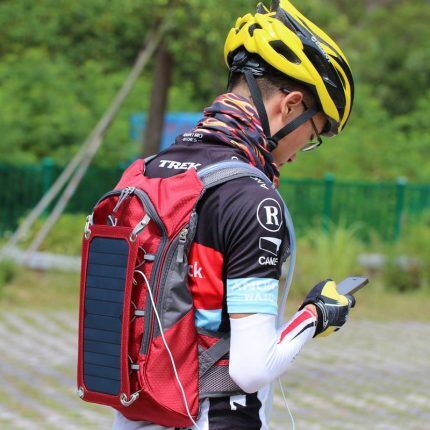
Folding beds – these can be either several flexible panels, compactly folded in a “stack”, or a variation of two monoblocks enclosed in a rigid case in the shape of a drop-down book.
The main goal of such a device is to minimize the “capture” of usable space in the volume of your luggage and increase efficiency due to a larger number of photocells. A nice bonus is that most models are equipped with mounts for a backpack or car window.
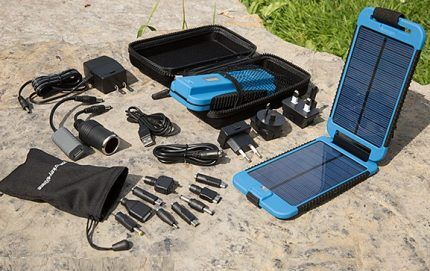
But regardless of the design, all solar chargers work on the same principle, so let’s look at important technical nuances that will help when purchasing a device.
How to choose the right option?
First, you should decide on the number and types of devices that you plan to charge using solar charging. The power of the device and the type of output port depend on these parameters.
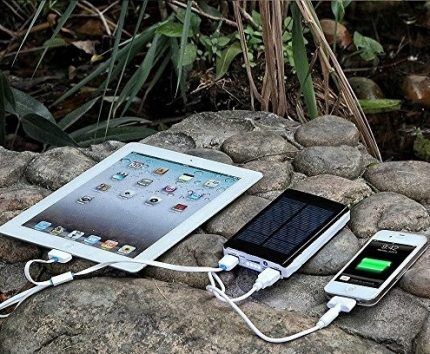
The characteristics of various devices can be clarified by looking at their operating instructions, and in some devices the operating voltage is also indicated on the charger that is included in the kit, so it will not be difficult to navigate. As a last resort, you can always purchase the necessary adapter.
Basic parameters and nice additions
The characteristics of the charging current determine the time it takes for the device to recharge various devices. This indicator is measured in amperes and is indicated on the ports of the device.
Values:
- 1 ampere – intended for mobile phones, electronic cigarettes, watches, players.
- 2 amps – suitable for tablets, smartphones, digital cameras and video cameras.
- 2.5-3 amperes – will cope with charging netbooks and laptops.
It is also important to know the output voltage, because the devices being charged can exceed the power of solar charging. So, for most phones and simple tablets you will need an output of 5 volts, for digital cameras and gaming gadgets - 9, and for laptops and car refrigerators - 12-24.
But still, the main characteristic of the charger is the power of the solar panel. The battery charging time directly depends on this indicator. And here it all depends on the characteristics of the light-collecting panels.
For example, elements with a power of 5 W (standard budget option) will have a current of 900 mA hours, and 10 W will have a current of 1500 mA. That is, to charge a phone from a 5 W solar charger, it will take 2-3 hours, but a 10 W panel will do it in an hour and a half.
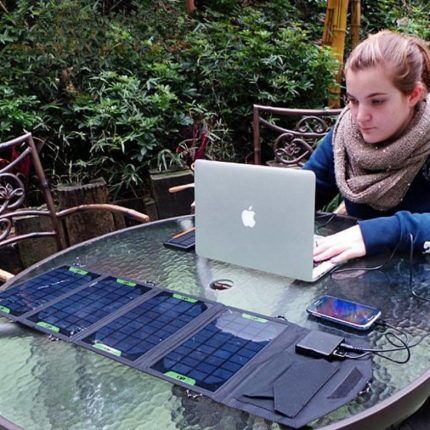
In addition, devices with panels whose power does not exceed 2 W are used only to accumulate charge of the built-in battery. And to directly charge devices from sunlight, you need panels with a power of 3 W or more.
Other important parameters:
- Battery availability – if the device does not have a storage device, it can only work while in a lighted place. Devices with batteries can supply charge at any time of the day, and can also be charged from other sources - a laptop USB port or an outlet connected to 220V.
- Type of photocells – it is believed that single crystals absorb sunlight more effectively (their efficiency is 13-18%). For polycrystals this figure is lower - about 10-12%. You can even distinguish them with the naked eye - polycrystalline panels have a dark blue tint, while their competitors are black.
- Interface – universal solar chargers are equipped with informative USB, where you can select the desired option depending on the type of discharged device. Some devices are also equipped with an indicator of the intensity of sunlight, which will help determine the optimal location for a quick charge.
- Protection – a priori, all devices have a security system that allows them to be used outdoors. But for lovers of extreme adventures, it is worth looking for a device with enhanced protection from rain, dust, dirt, shocks and other force majeure.
Additional features are most often represented by the “lantern” or “lamp” function. This may be relevant not only for lovers of outdoor recreation, but also for motorists - when changing a tire or making repairs on the road at night, a bright light will become an indispensable assistant.
Among other bonuses, manufacturers may offer a USB hub or Wi-Fi point. But, of course, any additions significantly increase the final cost of the product. Whether they are really needed is up to you to decide.
Our leading models in terms of shopping intensity are:
General recommendations for using the charger
Devices with a built-in battery must be fully charged before first use, not in the sun, but from the mains. Then connect any device to the charger so that it receives energy and discharges the drive.
After this, the panel can be exposed to the rays and compensate for the lost charge. For models operating directly from the sun, this rule does not work - they can be immediately installed in illuminated areas and connected to devices.

To maximize solar charging efficiency, we recommend the following:
- Position the device so that the rays fall on the panel at a right angle. Even if the sun is not at its zenith, you can give the charger the correct position by lifting it at an angle of 40 degrees with the help of some kind of support. This way you can collect 20-30% more charge than if you place the panel horizontally in a lighted place.
- Use the device together with a storage device, not only at rest stops, but also while traveling by car or on a hike.Such a tandem will be able to collect energy for 2-3 phone charges even in cloudy weather without direct sunlight.
- Keep in mind that in most folding devices the panels are connected in series, so it is important that all elements are evenly illuminated. For example, even if the shadow covers only half of the first of four panels, the battery power will drop by half.
- In order for high-capacity batteries to reach the stated parameters, it is recommended to “overclock” them - completely discharge them, then charge them to 100%. And so 3-4 times.
- During a long break in operation (a month or more), store the charger at room temperature. If this is a device with a built-in battery, it must first be charged to 50-70%.
And the last piece of advice - even if the charging has become worse or has completely broken down, do not disassemble it yourself, so as not to damage the system elements and the case itself. A disassembled device will automatically void the warranty, so it is better to contact an authorized service center or supplier.
How to make a charger with your own hands?
Although modern chargers have ceased to be premium devices and are quite affordable for the average consumer, if you want to save money, there is always the opportunity to make such a device yourself.

To make a simple solar charger you need to purchase several basic elements:
- poly- or monocrystalline panel;
- battery holder;
- Schottky blocking diode;
- connector socket;
- charge controller (however, if charging produces 0.5-5V, you can use a cheaper 5V boost converter instead of the controller).
As for the panel itself, here you need to make a small calculation of the number of elements, based on the power of the device that you plan to charge.
For example, if the charging current for the battery is about 10% of its capacity, then charging at 20,000 mA requires a current of 2A, and it will take about 14 hours to power the device. If you double the current to 4A, the charging time will be reduced to 7 hours.
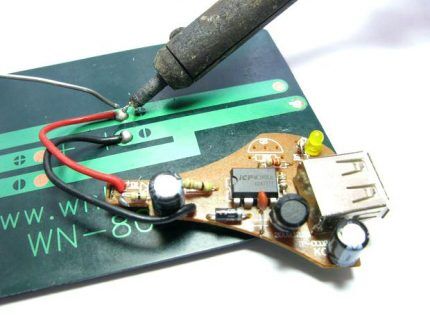
Depending on the current parameters for future charging (2 or 4A), crystalline elements are also selected. Typically, 1 part produces about 0.5V, that is, to get at least 5V you will need 10-12 elements.
Then they need to be soldered together in series. If you use a flashlight panel, then even a standard 70*70 cm can output from 2.5 to 4.5V, so it’s better to check with a voltmeter.
The final stage is to enclose the homemade charger in any suitable frame (even a candy jar will do) and equip it with a USB connector. Then you need to solder a blocking diode to the connector, as well as wires from the solar panel to the converter and holder according to the diagram below.

All that remains is to check the operation of the device in the sun with any discharged device.If everything is in order, you can use the appropriate adapters and charge various devices.
Photo instructions for do-it-yourselfers
You can easily assemble a compact charger with a USB port to power your phone with your own hands. All components are available for free sale; in extreme cases, they can be ordered. A homemade product will cost tens of times less than a factory-made product, especially if it is widely advertised.
When purchasing components for assembling the device, you need to take into account that the solar battery must be purchased with a voltage of 5V or more. We have already talked about the battery voltage, it is 3.7 V. However, we did not mention an important subtlety - “PCB protection” should be indicated in the battery labeling or technical documents. This means that it is protected from deep discharge and overcharging.
You will also need two 2.5 mm connectors: one with a latch on the panel, the second with a wire. You will also need a USB boost circuit to supply DC current.
Have you stocked up on everything you need? Let's start assembling:
In addition, you need to solder the diode. It is connected on one side by a wire to the battery, on the other - to the middle pin of the connector. It is advisable to make soldered connections as close to the diode as possible; all nodes must be protected with heat-shrinkable tubing or at least glue drops.
He will familiarize you with the rules for selecting solar panels for furnishing a private home or cottage. next articlededicated to this interesting issue.
Conclusions and useful video on the topic
To get a visual idea of solar chargers and the principles of their operation, we suggest watching our selection of videos:
Practical advice and tips on how to choose a charger for various devices. You can look inside and study the candy bar diagram together with the author of this video:
How to assemble a charger powered by solar rays with your own hands:
Thanks to technological progress and the bright minds of inventors who made solar energy accessible to ordinary users. Thanks to such chargers, you don’t have to worry about being left without communication with civilization at the right time while on vacation.
Well, if you have any difficulties selecting a device, you can always seek advice from professionals who are knowledgeable in electrical engineering.
Tell us about how you used solar charging while camping, on a picnic, or on the road. Please write comments in the block below. Ask questions, share your impressions and useful information on the topic, post photos.




In the summer I often go hiking for a week or two. Back in the spring I bought a charger in the form of a candy bar to recharge my camera and phone. During transitions I attached it to the top of my backpack, and gained weight, although more slowly than at a rest stop, but all the time. I still take a spare power bank in case of rain, but the overall packing weight has decreased, plus I can now use the phone more, for example, I read in the evening.
I read the article, and the question still bothers me: why are modern power banks so unsatisfactory? They take up less space, and their energy output is quite fast and does not require special conditions (for example, direct sunlight). In addition, they are widespread, you can find them in any electronics store, but I rarely see solar chargers, only in specialized centers.
It is clear that this is good for the environment and does not require power from an outlet.
But waiting for sunny weather, especially in the latitudes of the North-West (St. Petersburg, Murmansk), and even in autumn and winter... Well, that’s not an option at all.
But for a trip abroad, and even for a camping trip, I would buy such an eco-charger!)
I can answer why I didn’t like it: a small amount of charge. A powerbank, even with a large capacity, for all devices, if you find yourself away from civilization for a couple of weeks, it won’t be enough for a smartphone. A device that can draw energy from the sun is more productive.
If only because when you have a 30 kg backpack on your back, it’s a week’s journey to the nearest “outlet” (and for me up and even to the other side) somehow by itself it’s no longer necessary to carry a dozen “power cans” with you...
Well I do not know. Of course, solar panels are the future, I have no doubt about that. But at the moment they are still unnecessarily expensive with questionable effectiveness. So far this is not a “mass product with an affordable price.” A charger that costs half or even 2/3 of a smartphone is expensive.
Semyon, the issue of mass production is decided not only by price, but also by the need for such devices. Indeed, to recharge your phone once, a power bank is enough - it’s simpler. and cheaper.But if you, for example, are going rafting, or to the mountains for a week, then you won’t have enough power banks, and solar panels just solve the problem. But you’re right, people don’t go on such extreme adventures en masse.
Thank you The article is interesting, but it’s just not clear! The panel provides direct current, and the mobile phone is charged with alternating current. How to overcome this inconsistency?